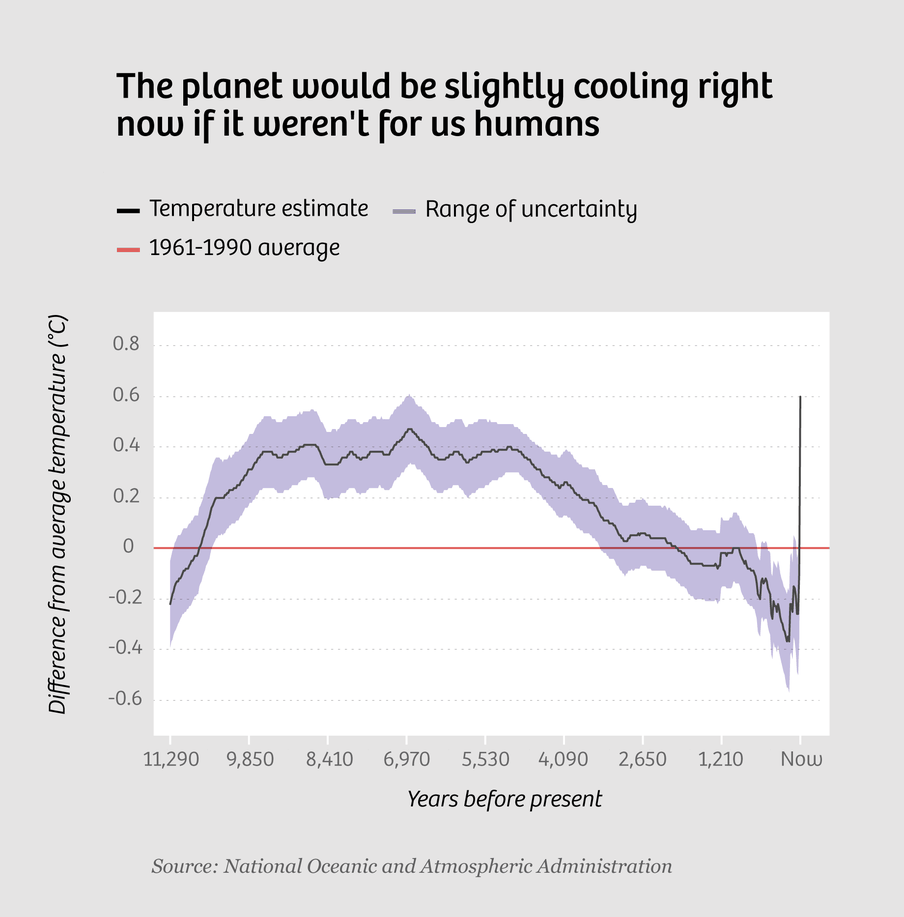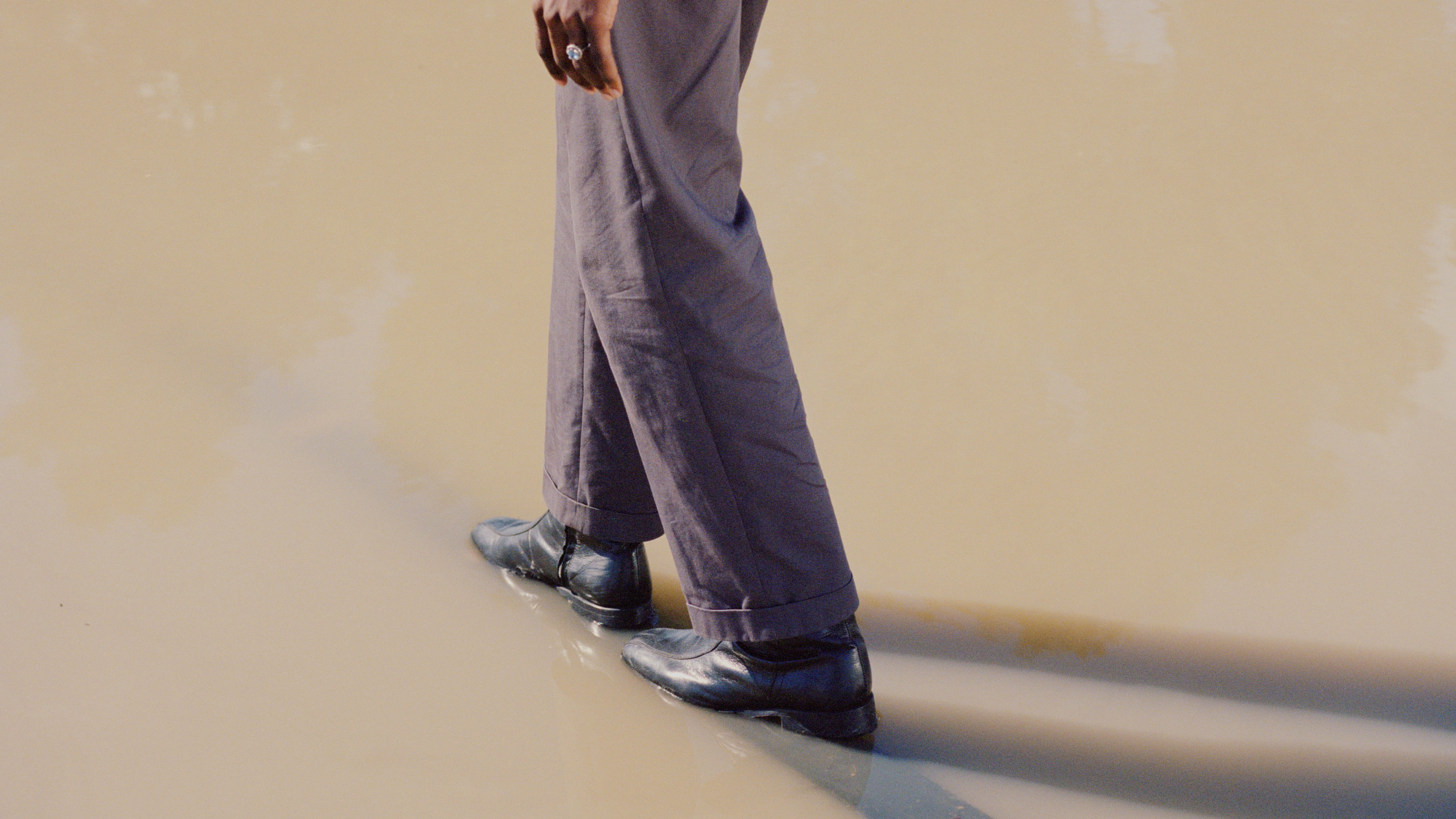There was once a time when the weather was the realm of the gods. Lightning strikes, tornadoes, droughts and floods were all subject to the whims of the divine – powers beyond not only humanity’s control but also beyond our comprehension.
It’s even written into our insurance contracts: “Acts of God.”
But over thousands of years, scientists have learned that the weather follows repeatable, predictable patterns. And one of the main stories of the past 100 years has been the realisation that human activities are powerful enough to bend those patterns. One of the main stories of the next 100 years will be whether or not we change those activities fast enough.
Within our lifetimes, something remarkable has happened. It’s no longer the gods that cause the most extreme of weather events. It’s us.

Human activities now affect every single weather event in every part of the globe. That’s not to say every single weather event is driven solely by human activities – the sun still drives the hydrologic cycle and all weather on Earth. But it’s no longer true to say that we live in a world where “natural” weather patterns exist.
Meteorological science has progressed so far that its implications are being written into law. One of the most rapidly developing fields of climate science is called "event attribution" – scientists can now assign a percentage of climate blame to every weather event, with specificity down to individual oil and gas companies.
Knowing that fossil fuel companies are directly responsible for imperceptible changes in daily weather is not hyperbole. It’s integral to our understanding of the new era we are now in.
The end of the era of climate stability
To put it simply, we’ve left the era of climate stability that’s given rise to human civilisation.

In the absence of human activities, the world would be slightly cooling right now. In fact, according to several assessments, humans are responsible for greater than 100% of global warming. We’ve offset the natural cooling trend, and then some. The planet’s temperature and chemistry are now changing at the sharpest rate in at least 55 million years.
If every part of the atmosphere has now been affected by humanity’s presence, we should pay just as close attention to the everyday subtle shifts in the weather as we do the headline-grabbing mega-disasters. It’s these steady changes, a degree or two here and there, year after year, that are breaking the system.
Climate change is no longer a prediction
Over all the millennia of our existence, weather disasters were deadly but temporary. Now, the worst of them are subtle, cumulative, and permanent.
Climate change is the shorthand term we have for that long-term, irreversible shift in the baseline conditions of our existence on the planet. On the timescale of a human lifetime, these shifts in the weather are barely perceptible. From the perspective of the global ecosystem, they are as loud and damaging as an asteroid strike.
Abrupt climate change used to be a prediction. Now it is recent world history, and the greatest shared threat we face as a civilisation. Air pollution – one of the world’s leading causes of death – already kills millions of people per year. By the end of the century, extreme heat alone could kill as many people as all infectious diseases combined do today. And none of this factors in the threat to the stability of nations as migration due to natural disasters approaches levels not seen since the second world war.

There are hundreds of examples of plants and animals whose long-term behaviours have already shifted due to subtle changes in the weather over the past few decades. Individually, these changes are not alarming. A certain species of plant blooming three days earlier, on average, shouldn’t matter much to a robust ecosystem.
But if nearly every animal and plant is changing their behaviour, the fragile relationships between them can fray remarkably fast. A certain type of bee may no longer be able to pollinate the flower it has co-evolved with over millions of years, and the migratory bird that depends on that plant’s fruit may now starve. If that bird needs to traverse the Arctic on its migration and there is no more sea ice, it may go extinct.
If that bird goes extinct, it won’t be because of a single extreme weather disaster; it will be because small shifts in the weather became too much for it to bear. Magnified over millions of species, and amplified over all the other environmental factors at work like habitat loss and pollution, you can gradually come to see why climate change is an existential threat. Not only because of rising seas and fiercer hurricanes but because the web of life on which our existence depends is fraying.
How the weather is different now
This era of irreversible weather disasters has arrived without a grand entrance, so it’s important to distinguish exactly what it looks like. Any time a system moves outside the range that it’s adapted to, it’s prone to breaking down. When it does so quickly, it could collapse.
There are several ways to think about how the weather is different now.
From a human perspective, some weather and climate events have been made better by climate change. There are fewer deaths from hypothermia in colder climates, like northern Europe. Some places with short growing seasons may begin to produce more food. Arctic countries may benefit from increased maritime trade as the sea ice melts and the shipping season lengthens.

But these trends don’t hold for the world as a whole. Northern Europe and Canada are the main beneficiaries of shorter winters, the same countries that have made a huge percentage of their fortunes from the fossil fuel industry.
Then there are weather events that are made worse by climate change. Nearly every new high temperature record, like the recent 37.8°C/100°F in London or the 54.4°C/130°F in California, was made more likely by climate change. The wind speeds of some extremely strong cyclones, like Hurricane Dorian’s impact in the Bahamas last year, are likely due in part to warmer ocean temperatures caused by climate change.
There’s evidence that certain heavy rain events – like this year’s exceptionally strong south Asian monsoon that has flooded large parts of India and Bangladesh – were also connected to warming oceans. But it’s plausible these events could have happened without climate change, even though their severity is increasing.
Some weather events, like 2018’s heatwave in Japan, were so unusual that they could not have happened without climate change. This year, another heatwave hit Japan with similar force. Recent heatwaves in the Middle East and south Asia are approaching the level at which human survival is impossible, which they are expected to reach by the end of the century if the world remains on anything like a business-as-usual course. As deadly as these heatwaves are, they aren’t irreversible. They didn’t kickstart some long-dormant Earth process on their own.

Climate ‘tipping points’
And then there’s the third category: weather events that, if they happen enough times in the same place, turn into climate disasters that alter the environment permanently.
These disasters are what we are trying to prevent when we take action on climate change. These are the disasters that, if left unchecked, will endanger civilisation as we know it.
Some of them are already underway: the loss of the Great Barrier Reef, the collapse of mountain glaciers worldwide, the desertification of the Mediterranean region. Some are already effectively irreversible, like the acidification of the oceans. All of them are causing immense suffering to people and to the biosphere in ways that rarely make the news.
These disasters happen through a process that scientists also call “tipping points”.
The phrase “tipping point” is often used as a colloquial way of saying things are starting to get really bad, but it’s also a technical term scientists use to describe a point at which a natural system in a steady state irreversibly transitions to an entirely new equilibrium.

The classic example is sea ice in the Arctic Ocean, which has been continuously covered with a bright white reflective layer of frozen seawater for thousands of years. The region is now one of the fastest-warming places on Earth, and as more dark blue liquid is exposed beneath the ice, the water absorbs more and more heat energy due to a lower albedo. The warmer the Arctic gets, of course, the faster it melts. The fear is that in just a few years, the Arctic will experience a “blue ocean event”, after which ice will have trouble reforming, sending a cascade of weather and ecosystem implications throughout the northern hemisphere.
It’s this category of climate consequences that are most worrying.
To name a few more:
When they burn, forest fires release huge amounts of carbon dioxide and soot that warm the atmosphere. This year’s fires in the Arctic alone have already released more carbon than Denmark, Sweden, Norway, and Finland will over the entire year from all human activities combined. Those additional emissions will warm the atmosphere further, boosting the likelihood of larger fires in the coming years.
And those fires, clearly, are already bad enough. Forest fires in the Amazon are happening at a frequency unseen in the past 20,000 years. Even the wetlands in Brazil are on fire. This year’s bushfires in Australia, one of the worst wildlife disasters in modern history, may have pushed at least 113 species closer to extinction.
Because of an increase in drought, floods, and heatwaves, climate change is already reducing crop yields worldwide. An overlap of crises in 2020 has kicked off the most severe global food shortage in 50 years. That’s just one of more than a dozen effects that the climate emergency is having this year, worsening the effects of the pandemic and stressing human systems to the breaking point.
A trend toward overlapping disasters is causing an exponential growth in the complexity and danger of every other type of disaster. As we saw during the Arab Spring revolutions, food crises can create political crises, which can destabilise governments and create humanitarian crises, which greatly reduce our ability to deal with the climate crisis.
When climate change makes the news – that “it’s worse than you think” story we all dread reading – this is what they’re talking about. Donald Rumsfeld, the US philosopher-military architect, had a famous saying about “known unknowns” and “unknown unknowns” that was meant to strike fear and build the case for rapid action. Climate change has reached the point where even the known unknowns should be enough for us to take action. No need to tempt the gods even more.

 About the images
Photographer David Ellingsen has been working on his series Weather Patterns for more than 9 years. Using a consistent set of parameters such as location, focal length, aperture and framing, he captured the landscape in front of him on a daily basis, interested by events related to the changing global climate system – such as temperature records, drought or wildfires. At a later stage, he would go back into his archive and assemble single pictures into a bigger composition.
About the images
Photographer David Ellingsen has been working on his series Weather Patterns for more than 9 years. Using a consistent set of parameters such as location, focal length, aperture and framing, he captured the landscape in front of him on a daily basis, interested by events related to the changing global climate system – such as temperature records, drought or wildfires. At a later stage, he would go back into his archive and assemble single pictures into a bigger composition.As viewers, if we consider the single landscape image as one shot, it is just the image of a regular sunset or a sea that we all experience during our lives. It is only by putting them together that we can perceive visually and materially that it is the accumulation of all those moments that lead to the tipping point of climate disasters. (Veronica Daltri, Image editor)
Dig deeper
 If we want the future earth we deserve, we need to do things that scare us
We’re at a transformative moment in history – from an old world based on extraction and exploitation to a new world we must create as we go. Embracing discomfort is at the core of climate action. And it’s something we’re all capable of.
If we want the future earth we deserve, we need to do things that scare us
We’re at a transformative moment in history – from an old world based on extraction and exploitation to a new world we must create as we go. Embracing discomfort is at the core of climate action. And it’s something we’re all capable of.
 One flight is worth a thousand Big Macs: digesting these hard facts killed my appetite for flying
Now is the moment to curb emissions from passenger air travel. Governments are failing to take the necessary steps – but you can.
One flight is worth a thousand Big Macs: digesting these hard facts killed my appetite for flying
Now is the moment to curb emissions from passenger air travel. Governments are failing to take the necessary steps – but you can.


